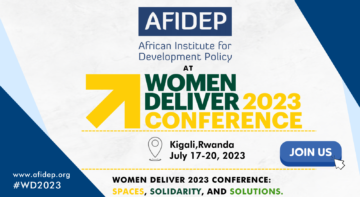News

Sub-Saharan Africa (SSA) is home to about 900 million people and this population is projected to grow to 2 billion by 2050.
The population has a youthful age structure, with 43 percent of the population below the age of 15 years. This age structure, which is primarily a result of persistently high fertility at a time when mortality has been steadily declining, exerts an enormous burden on the economy and undermines the capacity of families and governments to invest in human capital development.
If the region can achieve a rapid reduction in fertility (from the current level of 5.1 children per woman) in the coming decades, there will be a lower child dependency burden and a larger population at a working age.
Consequently, resources will be freed up to develop quality human capital through investments in education, health, and general family welfare.
These factors can propel high and sustained economic growth, referred to as the “demographic dividend“, if the economies generate enough quality jobs for the “surplus” labour force.
The magnitude of the demographic dividend, thus, depends on the rate of fertility decline, the ability of the economy to absorb and productively employ the extra workers, and the nature of economic reforms that countries adopt in order to encourage investment and savings.
The big question is “ what policy options should countries in SSA adopt in order to facilitate and seize the demographic dividend in the way that the Asian Tigers (Hong Kong, Singapore, South Korea, and Taiwan) did between the late 1970s and the end of the last century?
In the 1960s, sub-Saharan Africa and the Asian Tigers had similar socio-economic outcomes. However, between the 1970s and 1990s, the Asian Tigers invested heavily in health, family planning, education, and economic reforms.
According to estimates by Bloom and Williamson, between a quarter and a third of economic growth since the 1970s in those countries can be attributed to the demographic dividend.
Sub-Saharan Africa is among the regions with the most promising economies. An analysis by The Economist has shown that six of the world’s ten fastest-growing economies between 1990 and 2010 were in SSA.
Most economies in the region are projected to continue to grow substantially. The potential for economic prosperity is, in part, due to abundant mineral resources, direct foreign investment from the West, and increasingly, from China.
Not only is SSA a major world exporter of gold, uranium, iron ore, copper, bauxite, manganese chrome, and vanadium, but its recent discoveries of large deposits of gas and oil have shown significant prospects for the region’s economic development if these resources and the resulting revenue are properly managed and invested.
About 30 percent of all new oil and gas fields have been discovered in SSA, which includes discoveries of large deposits of natural gas in Mozambique and Tanzania, and new oil fields in Niger, Ghana, Uganda, and Kenya.
Persistent challenges threaten progress
The first challenge that threatens SSA’s capacity to benefit from the demographic dividend is its high fertility rate. SSA’s fertility rate of 5.1 children per woman is double the global average of 2.4 children. In some countries, such as Niger and Uganda, the average number of births is as high as 7 children per woman.
The rapid population growth that results from this high fertility exerts pressure on natural resources, undermines the preservation of natural resources, and the capacity of communities and countries to adapt to the effects of climate change.
In particular, the region’s over-dependence on an agriculture-based economy makes it uniquely vulnerable to the increasingly unpredictable weather patterns caused by climate change. These challenges undermine investment in human capital development, which is essential in order for the region to harness the demographic dividend.
Other challenges that can potentially derail Africa’s chances of seizing the demographic dividend are poor governance, political instability, and corruption. Improving governance and accountability will go a long way in increasing resources for developing human capital and the provision of infrastructure that is necessary in building strong economies. Furthermore, this will help attract and retain foreign investment.
Finally, African economies have not been creating enough jobs for the growing labour force, resulting in high levels of unemployment and underemployment, particularly among young adults.
Experience from the Arab Spring demonstrates the nature of turmoil and instability that countries in SSA are likely to experience if declines in fertility and a growing labour force are not be accompanied by reforms that will create fast-growing and job-creating economies.
Measures that can speed the demographic transition and demographic dividend
While there are questions about how fast fertility decline in SSA can occur, the notable reductions in fertility by a number of countries in Southern Africa and pockets of East Africa (e.g. Kenya, Rwanda, and Ethiopia), demonstrate that the region can overcome the factors that have prevented widespread fertility decline.
Furthermore, according to estimates by the Guttmacher Institute, about 53 million women in SSA have a desire and need for family planning that is not being met. In many countries, between a fifth and a third of married women would like to avoid pregnancy, but are not using contraception “ twice as high as in any other region of the world. This unmet need has stagnated at this level since the 1990s, with some indications that it is increasing.
Evidently, enhancing investments in addressing barriers of access and use of family planning will go a long way in reducing fertility in the region. According to results published in a recent special Family Planning issue of the Lancet, meeting the current levels of unmet need for family planning would help reduce fertility by an average of 1-2 children, and reduce about 29 percent of maternal deaths.
The progress in child survival that many SSA countries have achieved since 1990 should be sustained and reinforced in order to accelerate fertility decline and human capital development.
Investments in family planning and other public health issues must be accompanied by investments in education, which helps to reduce fertility by delaying the initiation of childbearing, empower women to develop productive skills, and increase their chances of working in the labour market.
SSA needs to enhance the ongoing economic growth, ensuring that it happens across the continent and is geared towards generating enough quality jobs for its growing labour force. Investments in infrastructural development, adoption of other pro-growth reforms, and enhanced governance and accountability in use of public resources will help make SSA the go-to investment hub of the future.
Of importance, the window of opportunity to benefit from the demographic dividend is short. SSA governments, the commercial sector, and other development actors need to act well in advance and quickly to enact appropriate policies and promote investments to enable SSA harness the demographic dividend and achieve sustained economic prosperity.
This article also appears in Africa UP Close: Southern Voices. Africa UP Close blog is a project of The Africa Program and The Project of Leadership and Building State Capacity at the Woodrow Wilson International Center for Scholars.
Related Posts





